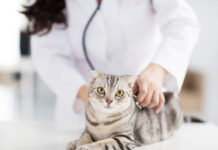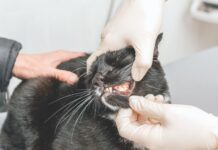Dear Friends,
Nothing brings home the seriousness of a medical condition like the frightening prospect of having the condition yourself, and I’d like to tell you about a recent scare that I had. We usually take questions from readers for this column, but please allow me to tell you about an important feline health issue.
It all started when my mom was petting me. She was stroking my belly and suddenly felt a small lump in my mammary region. She immediately became concerned and took me to the veterinarian.
After a complete physical examination (that tickled!), my veterinarian agreed that the lump was of concern. He explained that mammary cancers are among the most common cancers in cats, with a type called adenocarcinoma being the most common. Although benign tumors occur, they are relatively rare. He also explained that the majority of mammary adenocarcinomas are diagnosed in female cats between 10 and 12 years old (I’m slightly older) and that affected cats are most commonly intact (I was spayed years ago).
I had a series of tests, including chest X-rays to make sure that a cancer hadn’t spread (metastasized) to my lungs (thankfully, not) and blood work to make sure my organs were doing well (they were). The veterinarian then said, given the potential for adenocarcinoma, which is very aggressive, surgery would be the best course and that in the majority of cases, a radical mastectomy (removal of all the mammary glands on the affected side) is the treatment/diagnostic of choice because of mammary cancer’s high risk of recurrence. In some cases, a complete mastectomy, in which all the mammary glands are removed, is elected, depending upon the masses’ distribution and other issues like lymph node involvement.
In many cases, he said surgery is used with chemotherapy. A very important consideration and a factor in determining prognosis is the mass’ size. This was the scary part. Cats with tumors larger than 3 cm in diameter — slightly more than an inch — survive an average of four to six months. Tumors between 2 and 3 centimeters usually result in survival of about two years, and with tumors less than 2 cm in diameter, more than three years.
I felt my life pass before my eyes until the veterinarian said that my mass was about — drumroll here — one-half to three-fourths of a cm in diameter and that he did not feel any lymph node enlargement.
After a long discussion with my parents, during which they expressed concern for the discomfort that may result from a radical mastectomy and the likelihood that a tumor of this size would significantly shorten my life, they decided I would have a lumpectomy, with removal just the mass itself, along with wide margins around it. The veterinarian said that this was not the standard recommendation and that a radical mastectomy would be ideal, but he also said that he understood my parents’ position.
Surgery went surprisingly well, and everyone who took care of me was so wonderful. Recovery was relatively quick, and I got a lot of sympathy from many visitors (boy, did they spoil me!). We anxiously awaited the opinion of the pathologist, who would do a microscopic evaluation of the mass. When the results came back as benign hyperplasia of the mammary gland (a non-cancerous condition characterized by a mild overgrowth of mammary gland tissue), I let out a huge meow of relief, as did my parents. We all felt so lucky.
So, my feline friends, the take-home message is to have your owners examine you regularly and focus on the mammary region, as early diagnosis and treatment are the key to favorable outcomes with this disease.
I hope this letter finds you well and that you will go over to your parents, roll over on your back, and let them feel your belly. The worst that will happen is that you may get a jump on any problems in your mammary glands. The best is that you will get a belly rub. Sounds like a win-win to me! — Best regards, Elizabeth ❖



